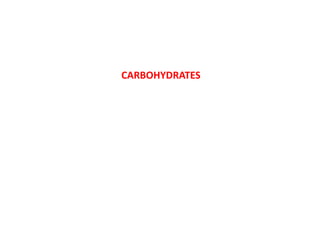
Introduction to Carbohydrates: Classification, Structure and Reactions
- 2. contents 1. Introduction to carbohydrates 2. Classification 3. Cyclic structure of monosachharides 4. Anomeric effect 5. Mutarotation 6. Osazone formation
- 3. Introduction Carbohydrates are polyhydroxy aldehydes or ketones. They are primarily produced by plants and form a very large group of naturally occurring organic substances. Some common examples are cane sugar, glucose, starch, etc. They have general molecular formulas that make them appear to be hydrates of carbon, Cn(H2O)n , from where the name carbohydrate was derived. Carbohydrates are formed in the plants by photosynthesis from carbon dioxide and water in the presence of sunlight (Scheme 1). Scheme 1 2. Classification Carbohydrates are classified into two main classes, sugars and polysaccharides. 1. Sugars Sugars are sweet crystalline substances that are soluble in water. These are further classified on the basis of their behavior on hydrolysis. 1. Monosaccharides The simplest form of carbohydrates is the monosaccharide. 'Mono' means 'one' and 'saccharide' means 'sugar'. Monosaccharides are polyhydroxy aldehyde or ketone that cannot be hydrolyzed further to give simpler sugar. They may again be classified on the basis of the nature of carbonyl group. Polyhydroxy aldehydes are called aldoses. Example: Glucose (Scheme 2) Polyhydroxy ketones are called ketoses. Example: Fructose (Scheme 2) 3
- 4. Scheme 2 The aldoses and ketoses are further divided based on the number of carbons present in their molecules, as trioses, tetroses, pentoses, hexoses etc. They are referred to as aldotrioses, aldotetroses, aldopentoses, aldohexoses, ketohexoses etc. Oligosaccharides Carbohydrates that produce two to ten monosaccharide units during the hydrolysis are called oligosaccharides. They can be further classified based on the number of monosaccharide units formed on hydrolysis. Disaccharides: They give two monosaccharide units on hydrolysis, which may be the same or different. For example, sucrose on hydrolysis gives one molecule each of glucose and fructose, whereas maltose gives two molecules of glucose (Scheme 3). Scheme 3
- 5. Trisaccharides: These carbohydrates yield three molecules of monosaccharides units on hydrolysis (Scheme 4). Scheme 4 Polysaccharides These carbohydrates give a large number of monosaccharide units on hydrolysis. These monosaccharide units are joined together by oxide bridges. These linkages are called glycosidic linkages. The common and widely distributed polysaccharides correspond to the general formula (C6H10O5)n . Polysaccharides are not sweet in taste, so they are called non- sugars. Some common examples are starch, cellulose, glycogen, etc (Scheme 5).
- 6. Anomeric Effect When a pyranose or furanose ring closes, the hemiacetal carbon atom is converted from a flat carbonyl group to an asymmetric carbon. Depending on which face of the (protonated) carbonyl group is attacked, the hemiacetal –OH group can be directed either up or down. These two orientations of the hemiacetal –OH group give diastereomeric products called anomers, and the hemiacetal or acetal carbon atom is called the anomeric carbon atom. The preference of certain substituents bonded to the anomeric carbon for the axial position is called the anomeric effect. Ano is Greek for “upper”; thus, anomers differ in configuration at the upper-most asymmetric carbon. The anomeric carbon is the only carbon in the molecule that is bonded to two oxygen atoms. The anomer with the anomeric –OH group down (axial) is called the α -anomer, and the one with the anomeric –OH group up (equatorial) is called the β -anomer (Scheme 4). Scheme 4 In fructose, the α -anomer has the anomeric - OH group down, trans to the terminal – CH2OH group, while the β -anomer has it up, cis to the terminal –CH2OH group (Scheme 5). Scheme 5 Mutarotation Normally D-(+)-glucose has a melting point of 146°C. However, when D-(+)-glucose is crystallized by evaporating an aqueous solution kept above 98°C, a second form of D-(+)- glucose with a melting point of 150°C can be obtained. When the optical rotations of these two forms are measured, they are found to be significantly different, but when an aqueous solution of either form is allowed to stand, its rotation changes. The specific rotation of one form decreases and the other increases, until both solutions show the same value. For
- 7. example, a solution of α -D-(+)-glucose (mp 146°C) specific rotation gradually decreases from an initial value of + 112.2° to + 52.7°, while The β -D-(+)-glucose (mp 150°C) specific rotation gradually increases from an initial value of + 18.7° to + 52.7°. The three forms of glucose reach equilibrium concentrations with the specific rotation of +52.7. This change ("mutation") in the specific rotation toward equilibrium is called mutarotation(Scheme 6).
- 8. Reactions Monosaccharides contain carbonyl functional group and alcohol functional groups, so it can be oxidized or reduced and can react with nucleophiles to form corresponding products. 1. Epimerization In the presence of base, D-glucose may be converted into D-mannose via the removal of hydrogen at C-2 carbon followed by protonation of the enolate (Scheme 1).
- 9. Osazone Formation Aldose and ketose react with one equiv of phenylhydrazine to produce phenylhydrazones. In contrast, both C-1 and C-2 react with three equivalent of phenylhydrazine to form a bis- hydrazone known as an osazone (Scheme 7). Scheme 7 The configuration at C-1 or C-2 is lost in the formation of osazone, C-2 epimers form identical osazones. For example, D-gluose and D-idose are C-2 epimers; both form the same osazone (Scheme 8). Scheme 8 Ketose reacts with phenylhydrazine at C-1 and C-2 position to form osazone. D-Glucose and D-fructose form the same osazone (Scheme 9). Scheme 9
- 10. Thank you